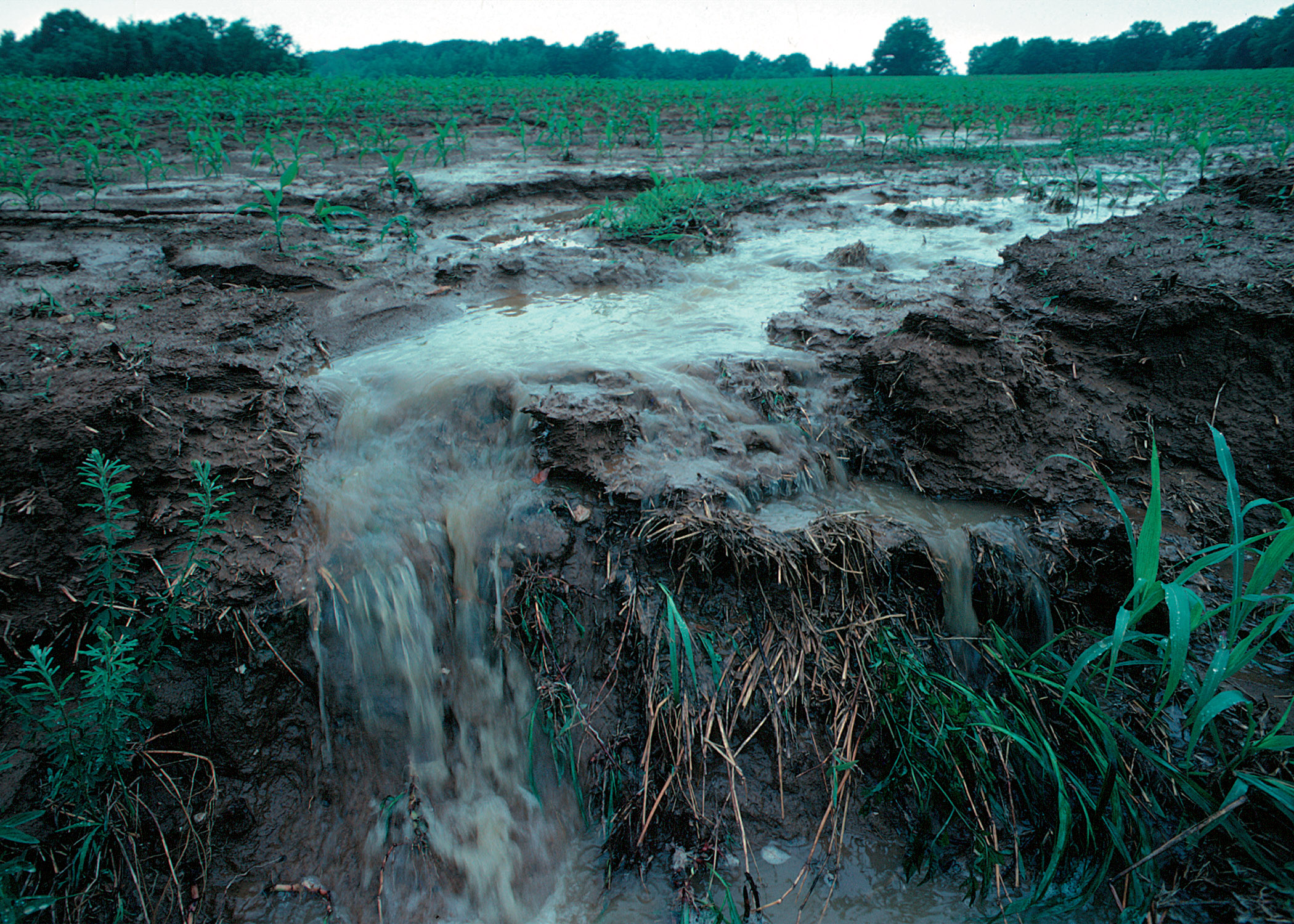What are algal blooms?
Algal blooms in Lake Erie have been an issue for the past 4 decades, yet they are still a growing concern for communities who rely on the lake for water, food, and other components of their life. Algal blooms are the rapid growth of algae or cyanobacteria that are easily recognized by the colored scum they create on the surface of the water (1). The main cause of algal blooms is excessive nutrient runoff, specifically phosphorus, that can originate from concentrated animal feeding operations, fertilizers, aquacultures, sewage discharge, or any number of other things that actively place more phosphorus into the water (2). Heavy rainstorms provide the largest phosphorus load, about 80-90 percent when fertilizer and other phosphorus sources are quickly washed into rivers and streams that flow into Lake Erie (3). Warm temperatures and light also encourage the growth of algae (4).

This image shows soil and fertilizer runoff from a farm. This runoff is often responsible for algal blooms. Credit: USDA (9)
Are all algal blooms dangerous?
Algal blooms are generally categorized into two groups, nuisance algal blooms (NABs) and harmful algal blooms (HABs). Nuisance blooms are called so because they change the color of the water, leave residue on swimmers skin, and are a nuisance to deal with, but they don’t pose a serious health risk. They are mainly responsible for aesthetic concerns at beaches and economic losses (1). However, they can act as a gateway to harmful blooms, which are called so because they are capable of producing toxins. Harmful algal blooms are concentrated growths of cyanobacteria that can produce toxins that are harmful to fish, aquatic life, humans, and other mammals such as dogs (1). Microcystis aeruginosa is blue-green algae (cyanobacteria) that is responsible for the majority of HABs in Lake Erie. Microcystis blooms produce the liver toxin microcystin that can cause skin rashes, gastrointestinal issues, liver, and nervous system damage, and in some rare cases can even be fatal if the bacteria is ingested (3). Studies are being done to determine if microcystin in fish could be harmful for human consumption. It was predicted that more toxic blooms would cause an increase in microcystin levels in fish, posing a greater risk to public health (5). Although not all cyanobacterial blooms produce toxins, it is best to steer clear of anything that looks like a cyanobacterial algal bloom.

This is an image of the October 9th, 2011 harmful algal bloom on Lake Erie. Credit: National Geographic (8)
How do HABs affect fish?
The toxins produced from HABs are often not directly harmful to fish but they can create other issues within the ecosystem that cause fish to die. The main threat that algal blooms pose to fish is that they often create “dead zones”, or areas with little to no dissolved oxygen in the water. These areas do not have enough oxygen for fish and other marine life to survive. This happens when the algae die and are decomposed by bacteria. The bacteria respire and use up all the oxygen in the water, thus creating a “dead zone” and anything living in the area will no longer be able to survive (6). This poses a threat to fisheries in Lake Erie, as recreational and commercial fishing industries may suffer as more fish are being killed in these dead zones.

This image shows a harmful algae bloom near Pelee Island on Lake Erie. Credit: NOAA Great Lakes Environmental Research Laboratory
What can be done?
The easiest way to reduce these massive algal blooms is to limit the number of nutrient inputs in the watershed. This is easier said than done, as many farms are already at recommended soil test phosphorus levels (7). However, there are many ways that you can help. It is recommended that managers, farmers, and citizens focus on adaptive management because not all farms or gardens are the same and options for reducing nutrient runoff may change over time (7). Also following the 4Rs for nutrient stewardship (applying the right fertilizers at the right rate, right time, and right place) can ensure that the safest measures are being taken. These can include refraining from applying fertilizers and manure to frozen fields, injecting fertilizers beneath the soil, and testing soils to make sure that healthy crops will get only as much fertilizer as they need (7). Lastly, slowing down the water in the watershed and the phosphorus that comes with it is an option that allows us to control the runoff even after the nutrients have been picked up. Many opportunities exist for this, but restoring natural wetlands, implementing controlled drainage structures, and using cover crops and buffer strips to filter the water before it gets to the lake are recommended (7).
References
- Weston, Claire. “Harmful Algal Blooms: What They Are, How to Spot Them, and What to Do If You Suspect You’ve Encountered a Bloom.” Community Science Institute, 31 July 2017, www.communityscience.org/2017/07/31/harmful-algal-blooms-what-they-are-how-to-spot-them-and-what-to-do-if-you-suspect-youve-encountered-a-bloom/.
- “Causes, Effects and Solutions to Eutrophication.” Conserve Energy Future, 15 Jan. 2017, www.conserve-energy-future.com/causes-effects-and-solutions-to-eutrophication.php.
- “Harmful Algal Blooms.” Ohio Sea Grant College Program, ohioseagrant.osu.edu/research/issues/habs.
- “Great Lakes Region.” Great Lakes Region RSS, www.regions.noaa.gov/great-lakes/index.php/project/harmful-algal-blooms/.
- Wituszynski, David M., et al. “Microcystin in Lake Erie Fish: Risk to Human Health and Relationship to Cyanobacterial Blooms.” Journal of Great Lakes Research, vol. 43, no. 6, Dec. 2017, pp. 1084–1090., doi:10.1016/j.jglr.2017.08.006.
- “The Effects: Dead Zones and Harmful Algal Blooms.” EPA, Environmental Protection Agency, 10 Mar. 2017, www.epa.gov/nutrientpollution/effects-dead-zones-and-harmful-algal-blooms.
- “Lake Erie Algae.” Lake Erie Algae, lakeeriealgae.com/.
- Borre, Lisa. “Harmful Algae Blooms Plague Lake Erie Again.” National Geographic Society Newsroom, 14 Dec. 2017, blog.nationalgeographic.org/2013/04/24/harmful-algae-blooms-plague-lake-erie-again/.
- “National Science Foundation – Where Discoveries Begin.” NSF, www.nsf.gov/discoveries/disc_images.jsp?cntn_id=298181&org=NSF.
